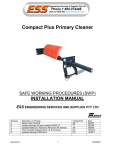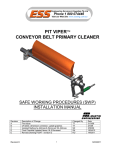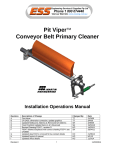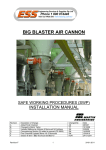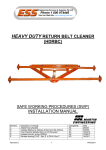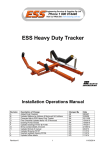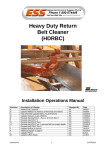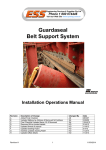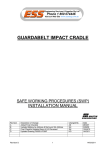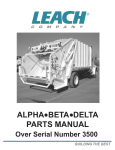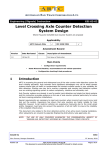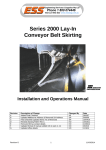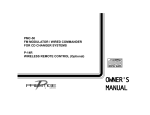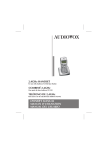Download RBC Installation Manual
Transcript
The ESS Brush Cleaner SAFE WORKING PROCEDURES (SWP) INSTALLATION MANUAL Revision A B C D E Revision E Description of Change Added Final Checklist Bearing information updated on drg F0258; Added Warranty Reg. & Hazards List. Added IP rating information on drg F0172 and F0258. Updated Melbourne Address & Removed SA Address Final Checklist Updated Items 4 & 5 Reversed 1 Changed By AS GC AS CW SH SH Date 28/5/07 19/10/07 23/01/09 3/08/09 15/04/10 15/04/10 ENGINEERING SERVICES and SUPPLIES OFFICE DETAILS ESS HEAD OFFICE 11-13 TRADERS WAY PO BOX 121 CURRUMBIN QLD 4223 P: (07) 5589 2000 F: (07) 5598 1353 ESS MACKAY 1 PROGRESS STREET PO BOX 5755 MACKAY MC QLD 4740 P: (07) 4952 4600 F: (07) 4952 4717 ESS PERTH 19 CLAVERING ROAD BAYSWATER WA 6053 P: (08) 9370 3155 F: (08) 9272 5130 ESS MAITLAND UNIT 2 BARTON COURT 6 JOHNSON STREET MAITLAND NSW 2320 P: (02) 4932 3544 F: (02) 4932 3611 ESS WOLLONGONG 1/20 DOYLE AVENUE PO BOX 343 UNANDERRA NSW 2526 P: (02) 4272 4422 F: (02) 4272 4434 ESS MELBOURNE 4/314 Governor Road BRAESIDE VIC 3195 P: (03) 9580 0388 F: (03) 9587 5199 ESS EMERALD 11/115 ROBERTS STREET EMERALD QLD 4720 P: (07) 4982 4855 F: (07) 4987 5118 ESS GLADSTONE 2/34 CHAPPLE STREET PO BOX 1475 GLADSTONE QLD 4680 P: (07) 4972 3759 F: (07) 4972 2866 ESS ADELAIDE P: (08) 8262 8955 F:(08) 8262 4944 ESS KALGOORLIE 4/235 HAY STREET PO BOX 10471 KALGOORLIE WA 6430 P: (08) 9021 7991 F: (08) 9021 7291 ESS MOUNT ISA 6 TRADERS WAY PO BOX 1554 MT ISA QLD 4825 P: (07) 4749 4580 F: (07) 4749 3019 CUSTOMER SERVICE NUMBER 1800 074446 TOLL FREE FROM ANYWHERE IN AUSTRALIA Revision E 2 15/04/10 WARRANTY NOTE ESS WARRANTS the ESS Product to be free of defects both in materials and workmanship for a period of 12 months from the date of despatch of the product from the ESS factory. The warranty given by ESS in this regard will extend only to replacing or repairing product shown to be defective. The warranty also is subject to the following restrictions: (a) Installation of the product contrary to the instructions contained in the supplied manual will void such warranty absolutely; (b) The warranty will not extend to any liability for injuries incurred and which result from the use of the product contrary to the instructions in the manual; (c) Save as prescribed by law, ESS will not be liable for any damage sustained by a purchaser or a third party by way of consequential loss arising out of defects in the product. You are asked to note that ESS offers purchasers a service whereby either: (a) It will install the product and certify the correctness of such installation, or (b) Certify the correctness or otherwise of the installation of the product by third parties. This certification service is designed to ensure that you obtain the full benefit of the ESS warranty hereby provided. If you would like to take advantage of the installation certification service provided, please contact ESS regarding the service. THE CONTENTS OF THIS MANUAL ARE COPYRIGHT TO: ESS ENGINEERING SERVICES AND SUPPLIES PTY LTD ALL RIGHTS RESERVED Information contained herein is for use in the operation of the ESS Brush Cleaner Conveyor Belt Cleaner, purchased from ESS and cannot be passed on to any other party without express permission, in writing, from ESS. Revision E 3 15/04/10 INDEX SECTION 1 SAFETY SECTION 2 INTRODUCTION SECTION 3 PREPARATION FOR INSTALLATION SECTION 4 INSTALLATION SECTION 5 ELECTRICAL CONNECTION AND CONTROL SECTION 6 COMMISSIONING SECTION 7 ROUTINE MAINTENANCE AND SERVICE SECTION 8 TROUBLE SHOOTING SECTION 9 INSTALLATION ARRANGEMENT DRAWING SECTION 10 EXPLODED PARTS LIST Revision E 4 15/04/10 SECTION 1 - SAFETY The ESS Brush Cleaner Conveyor Belt Cleaner is designed to be quickly and easily serviced by appropriate personnel. Under no circumstances should servicing or installation of the cleaner be carried out whilst the belt is in operation. Under no circumstances should servicing or maintenance of the cleaner be carried out whilst the Brush Cleaner is in operation. The conveyor must be shut down and locked out before any person enters or reaches into the conveyor enclosure. The ESS Brush Cleaner must be shut down and locked out before attempting any maintenance or adjustment. Ensure that only suitably qualified and trained personnel install and service this product. Ensure that all site and statutory safety procedures are followed. Electrical connections to the ESS Brush Cleaner must be carried out by a suitably qualified and licensed electrical tradesperson, and must comply with all appropriate Australian and site electrical and safety standards. Hazards that may be present when installing this equipment: Hazard Hazard X Moving Conveyor - ISOLATE Other: Hot Work Other: Working at Heights Other: Heavy Lift Other: Persons Working Overhead Other: Persons Working Below Other: Electrical & Cabling Other: Pinch Points Other: Trip Hazards Once hazards have been identified, the installer should undertake and document a comprehensive Job Hazard Analysis according to site requirements and good safeworking practice. The installer must identify all hazards and apply appropriate controls before proceeding with the installation of this equipment. Revision E 5 15/04/10 SECTION 2 - INTRODUCTION The ESS Brush Cleaner is a motorized rotary brush designed for use as a cleaning device for conveyor belts. It is normally located on the return side of the conveyor belt, as close as possible to the head pulley so that material brushed from the belt is delivered into the conveyor chute. The ESS Brush Cleaner rotates against the direction of belt travel at a speed of approximately 280 rpm. The ESS Brush Cleaner is often used as a secondary cleaner, and is preceded by a primary cleaner such as the ESS Trac-mount, Durt Tracker or XHD primary cleaners. The ESS Brush Cleaner has 100 mm wide segments so that the same spare part can be used for all belt widths. The brush is available with a range of bristle materials and thickness. Revision E 6 15/04/10 SECTION 3 - PREPARATION FOR INSTALLATION 1. CHECK INSTALLATION DRAWINGS - Ensure that you have the correct drawings and equipment for your conveyor(s). 2. PRE-ASSEMBLE THE CLEANER(S) AND MOUNTS - Do this in your workshop or similar free area, rather than at the Conveyor. This will enable you to: verify all required equipment is present familiarise yourself with the cleaner assembly allow you to plan the installation, reducing installation time. 3. ASSEMBLE THE NECESSARY TOOLS & SAFETY EQUIPMENT REQUIRED FOR THE INSTALLATION 4. OBSERVE THE CONVEYOR WHILE RUNNING AND CONVEYING MATERIAL Observe the belt splice condition Does the belt run true, or track off to one side? Is the Head Pulley out-of-round? Consult ESS if any UNUSUAL conditions are observed in the above. These conditions may result in recommendation of a different installation position or even a different cleaner. SECTION 4 - INSTALLATION DANGER! Conveyor must be shut down and locked out before installation is performed. WARNING! If installation is to be done in an enclosed area, test atmosphere for gas level or dust content. Follow all welding and safety guidelines. Protect belt surface from weld spatter with appropriate shield. NOTE Revision E For installation on enclosed head pulley chute work, draw all dimension lines on chute wall. In applications where head pulley is not enclosed, use the best available field resources and/or methods to ensure that these critical dimensions are followed for a proper installation. 7 15/04/10 4.1 Installation on Open Framed Conveyors Where the ESS Brush Cleaner is to be installed on an open framed conveyor, or in an area away from the chute enclosure, the following installation steps should be followed: Step 1 Determine the installation position for the ESS Brush Cleaner. This should be on a flat area of the return belt, and preferably in a position where the material removed from the belt will be captured and delivered onto the next conveyor, receiving hopper or the like. Mark the vertical centre line of the brush on the conveyor stringers or structure. Note: For conveyors that are inclined, the brush centre line is not vertical, but will be perpendicular to the belt line. Step 2 Measure 94 mm one side of the brush centre line, and mark another line, which represents the centre line of the mount bracket holes. The mount bracket can be either side of the brush – in other words, the mount brackets can be on the leading or trailing side of the brush, but must be the same on both sides of the conveyor. Step 3 Fabricate suitable brackets to attach the Brush Cleaner mounts to the conveyor stringers. The upper holes of the Brush Cleaner mounts should be 60 mm below the underside of the conveyor belt. See figure below. The non-drive side brackets must be easily removable (bolted) for future brush segment replacement. Revision E 8 15/04/10 Step 4 Attach the Brush Cleaner mounts to the fabricated brackets as shown. Ensure that the mounts are perpendicular to the conveyor belt, and that the adjusting screw is at the bottom of the mounts. Tighten the M16 bolts securing the mounts to the brackets. Step 5 Assemble the brush segments to the cleaner mainframe, and fit the lock each side. Centre the segments on the square tube, and secure the locks. Fit the bearing assemblies to each end of the mainframe, with the securing grub screws outwards. Do not tighten the grub screws at this point. Step 6 Lift the mainframe and brush assembly into place, and attach to the mounts by bolting the bearing housings to the slots in the mounts. Fit the torque arm anchor bracket to the drive side mount, positioning it on the opposite side of the mount bracket to the bearing housing, and sharing the bearing housing fasteners. With the bolts in the bottom of the slots, the top of the brush should be approximately 10 mm clear of the underside of the belt. Lightly tighten the bolts securing the bearing housings. Centre the brush segments to the belt by sliding the mainframe through the bearings. Tighten the grub screws securing the bearings to the shaft. Step 7 Fit the geared motor drive unit over the stepped end of the mainframe shaft. Ensure that the key is in place and aligned with the keyway before applying necessary force to fit the drive unit. Ensure that the torque arm is in place and aligned with the anchor bracket for the required motor orientation. The drive can be rotated to several positions, but the torque arm must be first repositioned so that it aligns with the anchor bracket. Step 8 Depending on the model, the torque arm anchor will be a length of threaded rod, or later a folded steel bracket. For the rod model, ensure that a nut and washer are fitted each side of the torque arm. Adjust the inner nut until the washer is contacting the torque arm. Adjust the outer nut until the washer contacts the torque arm, and then use spanners to tighten both nuts against the torque arm. For the steel bracket model, fit the smaller bracket to the slots in the larger bracket using fasteners supplied. Ensure that the smaller bracket is on the inside, or away from the drive unit, and that the hole in the small bracket aligns with the hole in the torque arm. Attach the smaller bracket to the torque arm using the single bolt supplied, and tighten securely. Tighten the bolts securing the smaller bracket to the larger bracket. The ESS Brush Cleaner is now installed and ready for electrical connection. Revision E 9 15/04/10 4.2 Installation on Enclosed Conveyor Chutes Where the ESS Brush Cleaner is to be installed on an enclosed conveyor chute, the following installation steps should be followed: Step 1 Determine the installation position for the ESS Brush Cleaner. This should be on a flat area of the return belt, and preferably in a position where the material removed from the belt will be captured and delivered onto the next conveyor, receiving hopper or the like. Determine by measuring the position of the conveyor belt, and mark this on the outside of the conveyor chute enclosure. Mark the vertical centre line of the brush on the conveyor chute enclosure. Repeat both sides of conveyor. Note: For conveyors that are inclined, the brush centre line is not vertical, but will be perpendicular to the belt line. Step 2 Using the marked centre lines and belt line, and the figure below, mark out the chute cut-outs. Ensure that the correct cut-out is marked for the Drive and Non-Drive sides of the cleaner. Future maintenance work will be most frequently performed at the Non-Drive side, so this side should have the best access. Ensure there is sufficient room for the drive unit on the side nominated as the Drive side. Note: The cleaner mounts can be either side (leading or trailing) of the brush, but must be the same both sides. Step 3 Fit the bearing units to the Brush Cleaner mounts using the bolts supplied. Ensure that the grub screws on the bearing hub are outward from the mounts, and that the bearing units are at the adjusting screw end of the slots in the mounts. Fit the Drive side mount and bearing assembly to the chute using the bolts supplied. Ensure that the correct side mount is used, and that the adjusting screw is at the bottom. Revision E 10 15/04/10 Step 4 Assemble the brush segments to the cleaner mainframe, and fit the lock each side. Centre the segments on the square tube, and securely fasten the Drive side lock only. Remove the Non-Drive side lock and the brush segments. Insert the shaft and lock stepped end first into the Non-Drive side cut-out, through the Drive side cut-out, and through the bearing on the Drive side mount. Ensure that the stepped end of the shaft is on the Drive side. Step 5 Supporting the shaft, fit the brush segments onto the Non-Drive end of the shaft, and push them through the chute cut-out – the brush bristles will distort to fit through the smaller opening. Fit all of the segments, ensuring that the furthest segment is in contact with the Drive side lock. Fit the Non-Drive side lock, and secure. Fit the Non-Drive side mount and bearing assembly to the shaft, and attach to the chute using the bolts supplied. With the bearing housings positioned in the bottom of the slots in the mounts, the brush bristles should be approximately 10mm clear of the underside of the belt. Step 6 Remove the nuts securing the Drive side bearing housing and fit the torque arm anchor bracket to the drive side mount, positioning it on the opposite side of the mount bracket to the bearing housing, and sharing the bearing housing fasteners. Refit the nuts and lightly secure. Centre the brush segments to the belt by sliding the mainframe through the bearings. Tighten the grub screws securing the bearings to the shaft. Step 7 Fit the geared motor drive unit over the stepped end of the mainframe shaft. Ensure that the key is in place and aligned with the keyway before applying necessary force to fit the drive unit. Ensure that the torque arm is in place and aligned with the anchor bracket for the required motor orientation. The drive can be rotated to several positions, but the torque arm must be first repositioned so that it aligns with the anchor bracket. Step 8 Depending on the model, the torque arm anchor will be length of threaded rod, or later a folded steel bracket. For the rod model, ensure that a nut and washer are fitted each side of the torque arm. Adjust the inner nut until the washer is contacting the torque arm. Adjust the outer nut until the washer contacts the torque arm, and then use spanners to tighten both nuts. For the steel bracket model, fit the smaller bracket to the slots in the larger bracket using fasteners supplied. Ensure that the smaller bracket is on the inside, or away from the drive unit, and that the hole in the small bracket aligns with the hole in the torque arm. Attach the smaller bracket to the torque arm using the single bolt supplied, and tighten securely. Tighten the bolts securing the smaller bracket to the larger bracket. Revision E 11 15/04/10 Step 9 If required for containment of dust, or to comply with plant safety rules, a cover may be fabricated and fitted to the chute opening, especially on the non-drive side. The cover must be easily removable for inspection of the brush, and must allow for vertical adjustment of the brush shaft. A typical cover is shown below. The ESS Brush Cleaner is now installed and ready for electrical connection. Revision E 12 15/04/10 SECTION 5 – ELECTRICAL CONNECTION AND CONTROL CAUTION The ESS Brush Cleaner is a motorised brush, with the motive power supplied by a 3phase electric motor. The drive motor must be connected in accordance with all site and statutory regulations, and only by a licensed and appropriately trained electrical tradesperson. Ensure that all power sources are isolated when working on or connecting exposed electrical cabling. 5.1 Control The ESS Brush Cleaner should rotate against the direction of the conveyor – see figure below. The ESS Brush Cleaner should be interlocked with the conveyor drive so that it operates only when the conveyor operates. A safety isolation switch should be located adjacent to the Brush Cleaner drive unit. A conveyor emergency stop or pull wire should be located adjacent to the Brush Cleaner on both sides of the conveyor. Stopping the conveyor should automatically stop the ESS Brush Cleaner. Additionally, the ESS Brush Cleaner may be connected with a selector switch that allows automatic starting of the cleaner whenever the conveyor starts, but also allows manual starting and stopping of the cleaner for maintenance and adjustment without the conveyor running. Revision E 13 15/04/10 A typical control circuit is shown below. Revision E 14 15/04/10 SECTION 6 – COMMISSIONING 6.1 Description Once the ESS Brush Cleaner has been electrically connected and tested, it can be adjusted for service. The ESS Brush Cleaner utilises jacking screws to adjust the brush to the belt. 6.2 Adjustment Procedure Slightly loosen the bolts securing the bearing housings to the mounts to just allow the housing to slide. Repeat for both sides. Ensure that the Torque Arm bracket remains in place on the drive side. Loosen the locknuts on the adjusting screws at the lower end of each support bracket. Turn the adjusting screw (equally on both sides) until the brush bristles are just touching the belt. The drive and torque arm assembly will automatically be adjusted via the anchor bracket. Ensure that the bristle contact is equal across the belt – that is, the bristles are just touching across the belt width. Continue turning the adjusting screw equally on both sides approximately 3 mm, or two turns. Do not over-adjust – the cleaning is done by the tips of the bristles, and excessive adjustment will result in poor performance and high wear. Re-tighten the bolts securing the bearing housings to the mounts, and tighten the locknuts on the adjusting screws. Start the conveyor and the ESS Brush Cleaner and observe the cleaning action of the brush. Ensure that the brush rotates smoothly against the belt with no vibration. Observe the belt surface after the ESS Brush Cleaner – is the brush cleaning the full belt area? If the belt surface is excessively worn, and the brush does not make full contact, allow a period of time (say 1 week) for the brush to wear to the belt profile, and then adjust two more turns of the screw. Revision E 15 15/04/10 SECTION 7 – ROUTINE MAINTENANCE AND SERVICE Regular inspection and servicing is the key to effective conveyor belt cleaning. It is recommended that the cleaner be inspected once per week initially. Actual service intervals will vary considerably from plant to plant. CAUTION! DO NOT REACH INSIDE THE CONVEYOR CHUTE UNDER ANY CIRCUMSTANCES WHILST THE CONVEYOR IS RUNNING. BEFORE ATTEMPTING ANY MAINTENANCE OR SERVICE WORK ON THE ESS BRUSH CLEANER, SHUT DOWN AND LOCKOUT BOTH THE CONVEYOR AND THE ESS BRUSH CLEANER. 7.1 Routine Inspection The following tasks should be undertaken during a routine inspection. Observe the conveyor belt after the ESS Brush Cleaner. Is the belt being cleaned uniformly? If the conveyor shows streaking or uneven cleaning, it may indicate that adjustment or brush segment replacement is required. Inspect the ESS Brush Cleaner drive unit. Ensure that the shaft is rotating smoothly. Check for noise or vibration. Check that all fasteners are secure. Check bearings and lubricate if necessary. If fitted, and if allowable under site regulations, remove the non-drive side cover plate and visually check the condition of the brush segments and bristles. Ensure that the bristle tips are making good contact with the belt. If any problems are identified with the ESS Brush Cleaner operation, adjustment or the condition of the bristles, arrange for the conveyor to be shutdown and service the cleaner as described below. 7.2 Re-adjustment Procedure Once the brush bristles wear, readjustment of the cleaner will be necessary. To readjust the cleaner, refer to the adjustment procedure in the Commissioning Section 6.2. Begin the re-adjustment by first reversing the adjustment procedure and backing the brush away from the belt by a few millimetres, inspect the bristles, and then follow the adjustment procedure. Revision E 16 15/04/10 7.2 Brush Replacement Do not attempt service on this cleaner with the belt or the cleaner running. Do not reach into the conveyor enclosure with the belt or cleaner running. Shut down, lock out and tag the conveyor and the ESS Brush Cleaner before attempting any maintenance that requires reaching into the conveyor enclosure. Step 1 Shut down and lock out the conveyor and the ESS Brush Cleaner as per site safety rules. Step 2 To access the brush segments, first fully de-adjust the cleaner by reversing the adjustment procedure as described section 6.2. When adjusting or deadjusting the cleaners, ensure that this is done evenly on both sides. Alternate sides at each turn of the adjusting rod or use an assistant. If the Brush Cleaner is on an enclosed conveyor chute, remove the non-drive side cover (if fitted). Visually inspect the brush segments and bristles. If bristles are clean, and not excessively worn, re-tension the cleaner and return to service. If bristles are excessively worn or damaged, proceed. Step 3 When fully retracted, loosen the grub screws securing the non-drive side bearing to the shaft. Unbolt non-drive side mount and bearing assembly (and bracket for the open conveyor installation) and remove the complete assembly from the cleaner shaft, taking care to support the end of the shaft. Step 4 Reach in and remove the non-drive side blade lock, sliding it from the shaft. Slide the brush segments individually from the shaft. Worn brush segments should easily fit through the access cut-out. Clean any material build-up from the shaft. Step 5 Fit new brush segments by sliding them onto the cleaner shaft. The bristles of the new segments will easily bend to fit through the access cut-out. Ensure the new segments are in contact with the drive side lock and each other, then refit the non-drive side lock. Step 6 Refit the non-drive side bearing and mount (and bracket) assembly, and tighten the grub screws securing the bearing to the shaft. Step 7 Adjust the brush to the belt as described in section 6.2. Refit the non-drive side access cover. Step 8 Return the ESS Brush Cleaner and the conveyor to service. Revision E 17 15/04/10 SECTION 8 – TROUBLE SHOOTING PROBLEM - High brush wear rate. CAUSE Cleaner over-tensioned SOLUTION Re-tension the cleaner as described in section 6.2. Incorrect brush material Contact ESS for re-appraisal PROBLEM - Insufficient cleaning - too much carryback. CAUSE Cleaner under-tensioned SOLUTION Re-tension cleaner as per section 6.2. Cleaner not rotating in the correct direction. The cleaner must rotate against the belt travel direction. If incorrect, have an electrical tradesperson change the drive direction. Remove brush segments and clean. Contact ESS for alternative brush materials. Service the Primary Cleaner Build-up on brush Primary Cleaner not functioning correctly Incorrect Brush Material Contact ESS for alternative materials Cleaner overloaded Add additional cleaner Cleaner not suitable for product Brush Cleaners work best on dry powders and stringy dry materials. Excessively wet or sticky materials may cause blinding of the brush and subsequent poor performance. Contact ESS. Revision E 18 15/04/10 SECTION 9 – INSTALLATION ARRANGEMENT DRAWING Revision E 19 15/04/10 SECTION 10 – EXPLODED PARTS LIST Revision E 20 15/04/10 FINAL CHECKLIST Site: ____________________________ Number: _____________________ Site Equipment No./Location: _________________________ Date: ___________________ Site Contact: _________________________ Completed By: _____________________________________ (Circle Yes or No Below) 1. Was equipment to ESS Specification? _______________________________ Yes/No Drawing No. Ref: _________________________________________ Attached? Yes/No If No, WHY _______________________________________________________________________________ ________________________________________________________________________________________ Will this affect performance? Yes/No If Yes, WHY ______________________________________________________________________________ ________________________________________________________________________________________ 2. Was this a standard service inspection installation? Yes/No If No, WHY _______________________________________________________________________________ ________________________________________________________________________________________ 3. Was work carried out as per procedure and JSA? Yes/No If No, WHY _______________________________________________________________________________ ________________________________________________________________________________________ 4. Is equipment fit for commissioning? Yes/No If No, WHY _______________________________________________________________________________ ________________________________________________________________________________________ 5. Was a final inspection carried out while plant was running? Yes/No If No, WHY _______________________________________________________________________________ ________________________________________________________________________________________ 6. Has anything changed from previous service / inspection / installation? Yes/No If Yes, WHAT _____________________________________________________________________________ ________________________________________________________________________________________ 7. Is equipment performance to Client expectations? Yes/No If No, WHY _______________________________________________________________________________ ________________________________________________________________________________________ ESS Signature: ______________________________ Revision E 21 Client Signature: ____________________________ 15/04/10 ESS ENGINEERING SERVICES & SUPPLIES PTY LTD WARRANTY REGISTRATION FORM Installer/Purchaser to fill out form & fax or scan/email to ESS Engineering Services & Supplies Pty Ltd Fax: 1800 824 446 Email: [email protected] Company: .............................................................................. Site: ....................................................................................... Contact: ................................................................................. Contact Phone: ...................................................................... ESS Equipment: .................................................................... .............................................................................................. Purchase/Delivery Date: ........................................................ Order No.: ............................................................................. Installed by: .................................. Date:............................. On Conveyor/Equipment No.: ................................................ NOTE: This Equipment is guaranteed to be free of defects in material and manufacture for a period of 12 months from the date of purchase/delivery. If the ESS product is found to be faulty, or if any problems are encountered with the equipment, contact ESS on 1800 074 446. Revision E 22 15/04/10






















